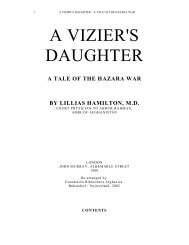The Inquiry into the History of the Hazara Mongols of ... - Hazara.net
The Inquiry into the History of the Hazara Mongols of ... - Hazara.net
The Inquiry into the History of the Hazara Mongols of ... - Hazara.net
Create successful ePaper yourself
Turn your PDF publications into a flip-book with our unique Google optimized e-Paper software.
are mentioned in <strong>the</strong> literature94 that it would be unpr<strong>of</strong>itable to speculate as<br />
to which, if any <strong>of</strong> <strong>the</strong>m, might have been <strong>the</strong> founder <strong>of</strong> <strong>the</strong> Dai Zangi.<br />
<strong>The</strong> names <strong>of</strong> many <strong>Hazara</strong> tribes and sub-tribes cannot be traced in <strong>the</strong><br />
historical record. Some bear <strong>the</strong> names <strong>of</strong> historically unidentifiable founders,<br />
such as Sultan Ahmad, Darwesh Ali, Abdul. Some are descriptive, probably<br />
<strong>of</strong> <strong>the</strong> founder, although <strong>the</strong>y might be proper names: Bacha-i Ghulam ("son<br />
<strong>of</strong> a slave") ,95 Mir-i Hazar (Emir or commander <strong>of</strong> a regiment), Daulat ("gov-<br />
ernment") Khan.96<br />
Some <strong>of</strong> <strong>the</strong> tribes or sub-tribes take <strong>the</strong>ir names from places. For example,<br />
<strong>the</strong> Yek Aulang tribe derives its name from a valley in <strong>the</strong> Hindu Kush which<br />
was already known by <strong>the</strong> name in <strong>the</strong> time <strong>of</strong> Timur.97 <strong>The</strong> "Turkman<br />
<strong>Hazara</strong>s" mentioned by Babur appear to have derived <strong>the</strong>ir name from a place<br />
ra<strong>the</strong>r than from any supposed affiliation with <strong>the</strong> Turkomans.98<br />
O<strong>the</strong>r sub-tribes have such names as Zardalu (Persian, "apricot"), and<br />
Shirin (Persian "sweet").<br />
Attempts to trace <strong>the</strong> origin <strong>of</strong> modem <strong>Hazara</strong> tribal names to Mongol tribes<br />
or to leaders who left <strong>the</strong>ir mark on western Mongol history can be only sug-<br />
gestive. Mongol tribal history is marked by a restless movement, a succession<br />
<strong>of</strong> alignments and realignments <strong>of</strong> <strong>the</strong> loyalties <strong>of</strong> leaders and <strong>the</strong>ir followers.<br />
When <strong>the</strong>y entered Afghanistan, particularly <strong>the</strong> central mountain area, <strong>the</strong>y<br />
stepped beyond <strong>the</strong> borders <strong>of</strong> recorded history. That names once fixed do not<br />
necessarily persist indefinitely is indicated by <strong>the</strong> fact that no tribal unit, so far<br />
as this writer has been able to discover, retains <strong>the</strong> name <strong>of</strong> Sultan-Mas'udi,<br />
which according to Babur was <strong>the</strong> most numerous <strong>Hazara</strong> tribe at <strong>the</strong> beginning<br />
<strong>of</strong> <strong>the</strong> sixteenth century.99<br />
WASHINGTON UNIVERSITY<br />
SAINT Louis, MISSOURI<br />
HAZARA MONGOLS 247<br />
94 Minhaj-ud-Din, vol. 1, pp. 175, 342; vol. 2, p. 1002; Howorth, vol. 3, p. 319; de<br />
Guignes, "Exposition de ce qu'il y a de plus remarquable (sur la terre) et des merveilles<br />
du roi tout-puissant. Par Abdorraschid, fils de Saleh, fils de Nouri, surnomme Yakouti.<br />
Ouvrage de geographie, compose dans le XVe si&cle" (in Notices et Extraits des Manuscrits<br />
de la Biblio<strong>the</strong>que du Roi, vol. 2, pp. 386-545, Paris, 1789), p. 474.<br />
95 Ghulam is, however, an Islamic name in good standing, so that Bacha-i Ghulam might<br />
be translated as "son <strong>of</strong> Ghulam."<br />
96 Daulat might be derived from <strong>the</strong> Chagataian tribal name Dughlat.<br />
97 Quatremere, Matla-assaadein, p. 120.<br />
98 Beveridge, Babur-nama in English, vol. 1, pp. 251-252. Some <strong>of</strong> <strong>the</strong> Turkman <strong>Hazara</strong>s<br />
were reported camping at Dara-i-Khush, northwest <strong>of</strong> Kabul, <strong>of</strong> which Beveridge writes<br />
"it seems to be <strong>the</strong> Dara-i-Turkman <strong>of</strong> Stanford" (idem, vol. 1, p. 251, note 1). Masson,<br />
writing in <strong>the</strong> ni<strong>net</strong>eenth century, speaks <strong>of</strong> <strong>the</strong> <strong>Hazara</strong> district <strong>of</strong> Turkoman (Masson,<br />
Narrative, vol. 3, p. 119).<br />
99 Babur-nama in English, vol. 1, p. 221.



